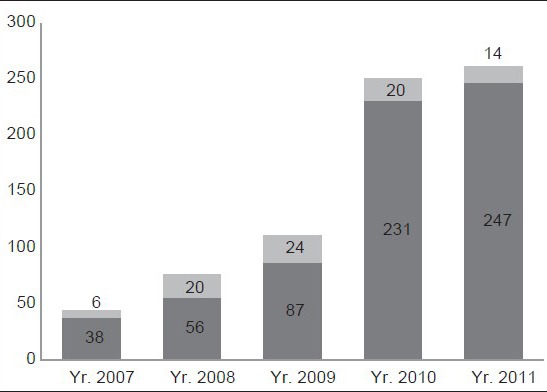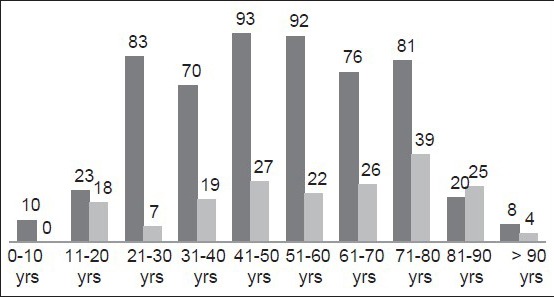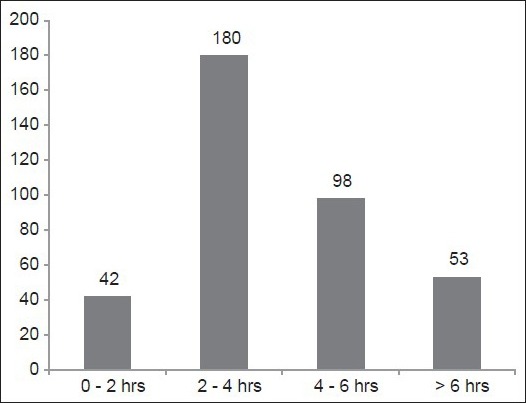Abstract
Purpose:
The purpose of this study is to analyze the donor and tissue profile of a community eye bank in Eastern India.
Materials and Methods:
Eye bank records were analyzed for the period July 2007-June 2011. Variables analyzed included donor demographics (age, gender, and ethnicity), donor cause of death, consent for recovery, death-to-preservation interval, preservation-to-utilization interval, endothelial cell density (ECD), corneal suitability for transplantation, and corneal tissue utilization.
Results:
During this study period, 743 corneal tissues were retrieved from 373 donors (male:female = 263:110). The mean age of donors was 52 ± 21 years (range: 3-95 years). The most common donor age group was 41-50 and 71-80 years. Most of the donors belonged to one religious faith (99%). The most common causes of death were cardiorespiratory failure (34%) followed by road traffic accident (30%). Majority donors were motivated (n = 320; 86%), and remaining (n = 53; 14%) were voluntary. Most of the consents were given by sons or daughters of the deceased (45%) followed by siblings (18%). Mean death-to-preservation interval was 3.9 ± 1.9 h. Mean preservation-to-utilization interval was 56.0 ± 24.4 h. The mean ECD of donor corneal tissue was 2857 ± 551 cells/mm2 and the median value was 2898 cells/mm2. Of harvested corneas 556 (75%) corneal tissues were utilized. The most common causes of nonutilization were septicemia in donor (n = 56; 30%) and poor quality of tissue (n = 55; 30%).
Conclusions:
Although, there is significant corneal tissue utilization, there is a need for increased awareness among people in order to augment voluntary donations.
Keywords: Corneal blindness, community eye banking, keratoplasty
In India, there are an estimated 12.2 million blind people with vision ≤6/60 in at least one eye and of these, 1% have bilateral corneal blindness.[1] A large proportion of the corneal blind in the country is avoidable.[2] Although studies have shown that 50.7% of the general population are aware of “eye donation” in India, only a few (<5%) know that this should be done within the first 6 h of death, and 20% had heard about corneal transplantation.[3,4]
In general, collection of the cornea is least in Eastern India compared with other parts of the country.[1] This eye bank is one of the largest community eye banks of Eastern India. Corneal tissues are collected for this eye bank either from hospital under the Hospital Cornea Retrieval Program (HCRP) or from home deaths. The aim of our study is to analyze the donor and tissue profile of this community eye bank.
Materials and Methods
A retrospective analysis of eye bank records was carried out during a 4-year period (from July 2007 to June 2011). Variables analyzed included donor demographics (age, gender and ethnicity), donor cause-of-death, consent-for-recovery, death-to-preservation interval, preservation-to-utilization interval, endothelial-cell-density, corneal-tissue-suitability for transplantation, and corneal-tissue-utilization.
Corneal buttons were collected and preserved directly in the McCarey-Kaufman (MK) medium at the site of excision and kept in the tissue-carrying boxes. All corneal tissues were preserved in the refrigerator at 4°C in the eye bank. Slit-lamp evaluation and endothelial cell count with KeratoAnalyser (EKA-04, Konan Medical Inc., Japan) were carried out.
Results
During the 4-year study period, 743 corneal tissues were retrieved from 373 donors (male:female = 263:110). The data revealed that there was an increase in the number of eye donations each successive year [Fig. 1a]. Most of the donors belonged to the age-group: 41-50 and 71-80 years (16%; n = 60) [Fig. 1b]. Of these, majority were above 40 years of age (69%; n = 257). The mean donor-age was 52.3 ± 21 (median = 53, range: 3-95) years.
Figure 1a.

Year-wise distribution of donors (hospital and home), figures in bracket represent number of donors
Figure 1b.

Age-group wise distribution of corneal tissues (used and not-used), figures in bracket represent number of donors
The most common donor cause-of-death was cardiorespiratory failure (34%; n = 127), followed by road traffic accidents (30%; n = 113), poisoning (3%; n = 13), septicemia (3%; n = 12), malaria (3%; n = 10), cancer (1%; n = 5), hemorrhage (1%; n = 4), anemia (1%; n = 2), and miscellaneous (23%; n = 87). Majority of the donors was motivated (86%; n = 320) by eye donation counselors, and the remaining were voluntary (14%; n = 53) [Fig. 1a]. Most of the consents were given by sons or daughters of the deceased (45%, n = 167). Death-to-preservation time was analyzed and found that the majority of the tissues was retrieved within 6 h of death (86%; n = 320) [Fig. 1c]. The mean death-to-preservation time was 3.9 ± 1.9 h. The preservation-to-utilization time was analyzed and found that 72% (n = 398) of the corneal tissues were utilized within 96 h [Fig. 1d]. The mean preservation-to-utilization time was 56.0 ± 24.4 h.
Figure 1c.

Death-to-preservation time of the donor corneal tissues
Figure 1d.

Preservation-to-utilization time of the donor corneal tissues
Majority (68%; n = 504) of the corneal tissues had endothelial cell density (ECD) of >2500 cells/mm2 followed by 112 (15%), 26 (3%), 11 (1%) corneal tissues had endothlial density of 2001-2500, 1501-2000 and 0-1500 cells/mm2, respectively. One hundred ninety-five tissues from 98 donors ≥70 years of age were collected. Of these, 121 (62%) tissues were utilized. Sixty-six (of 121) utilized tissues had >2500 cells/mm2 endothelial count. Specular microcopy images could not be done in 90 (12%) corneal tissues due to poor quality. Of the total 743 harvested corneas, 556 (75%) were utilized in different types of keratoplasty procedures (optical [n = 305], deep anterior lamellar keratoplasty [n = 11], Descemet's stripping endothelial keratoplasty [DSEK] [n = 70], therapeutic [n = 169], corneal patch graft [n = 1]). The most common causes of nonutilization of the corneal tissues were septicemia in donor (30%; n = 56), poor tissue quality (29%; n = 55), poisoning (11%; n = 20), donor on ventilator (6%; n = 12), donor blood not collected (3%, n = 3), no recipient available (4%, n = 7), and miscellaneous (17%; cancer metastasis and leukemia, n = 10; tissue damaged during preparation of donor lenticule for DSEK, n = 7; seropositive, n = 4; drowning, n = 2; others, n = 8).
Discussion
We revealed that tissue collection was less in the initial years; however, the numbers increased steadily with time. The donor-age distribution from other eye banks reveals that the majority of the donors are over 60 years of age with a large population between 70 and 80 years age-group.[5,6] On the contrary, in our study, majority of the donors are between 41 and 50 years age-group. This may be because of the higher number of deaths due to road traffic accidents in this group. The most common cause-of-death among donors in our study was cardiorespiratory failure (34%) followed by road traffic accident (30%). Patel et al. have shown cardiovascular diseases (50.5%) as the major cause of death followed by trauma (12.5%).[6]
Our data reveals that the majority of donations were motivated (86%) in contrast to voluntary donations (14%), which show a lack of awareness among people regarding eye donation. This calls for increased awareness among people for eye donation. Of the total 743 corneal tissue collected, 659 (89%) were collected from different hospitals, while 84 (11%) were collected from home. In contrast, Dosar et al. have shown the majority collection from home deaths (75.2%) followed by hospitals (21.5%) and mortuary (3.3%). Death-to-preservation time was analyzed and found that the majority of the tissues were retrieved within 6 h of death (86%). The mean death-to-preservation time was 3.9 ± 1.9 h, which is far better than a study by Patel et al., who have shown this interval to be 15.2 ± 6.2 h.[6]
The mean ECD of donor corneal tissue was 2857 ± 551 cells/mm2. Majority (68%) of corneal tissues had ECD > 2500 cells/mm2. Our data are comparable to the data of Patel et al., where they found the mean ECD of transplanted corneas to be 3024 ± 324 cells/mm2.[6]
We have collected 743 corneal tissues during the study period, of which 556 were utilized in different keratoplasty procedures. Our corneal tissue utilization is comparable to Patel et al. (79.1%)[6] but better than Dasar et al. (36%).[5] According to Patel et al., most common reason of nonutilization of corneal tissue was biologic contamination (5%) followed by abnormal serology (3.9%) and failed endothelial assessment (2.6%).[6] In our study, the utilization rate of donor corneal tissue is good. This may be attributed to direct preservation of the corneal button in MK medium at the site of excision, less death-to-preservation interval (<6 h) in the majority of cases, good ECD of corneas (68% have ECD >2500 cells/mm2).
In spite of the fact that we have significant utilization of donor corneal tissue, the public awareness regarding eye donation is very limited. This is supported by our data that the majority of donations were motivated (86%) where we have eye donation counselors, and there are a significant number of cornea collections through the HCRP. The increase in cornea collection in the recent years is attributed to the success of HCRP as well as trained grief counselors. In places where there is limited public awareness, cornea collection may be increased initially by implementing the HCRP. We conclude that there is a need for increased awareness among people in order to augment voluntary donations.
Acknowledgment
The authors are thankful to Ms. Debasmita Sur and Ms. Debasmita Sahu of Drushti Daan eye bank, Bhubaneswar, Odisha for their assistance during the preparation of the manuscript. The authors express special thanks to the Management of Drushti Daan Eye Bank for their cooperation and encouragement which helped in the completion of this work. Also, the authors like to thank Dr Taraprasad Das for his guidance and expert contributions to this work.
Footnotes
Source of Support: Nil.
Conflict of Interest: None declared.
References
- 1.Managing Corneal Blindness. National Programme for Control of Blindness in India. Quarterly Newsletter. 2012 Apr-Jun [Google Scholar]
- 2.Thylefors B, Négrel AD, Pararajasegaram R, Dadzie KY. Global data on blindness. Bull World Health Organ. 1995;73:115–21. [PMC free article] [PubMed] [Google Scholar]
- 3.Dafne LP, Dangre DM, Patil AB, Wangikar VD. Who cares for eye donation? Int J Public Health Hum Rights. 2012;2:11–5. [Google Scholar]
- 4.Priyadarshini B, Srinivasan M, Padmavathi A, Selvam S, Saradha R, Nirmalan PK. Awareness of eye donation in an adult population of southern India. A pilot study. Indian J Ophthalmol. 2003;51:101–4. [PubMed] [Google Scholar]
- 5.Dasar LV, Jayashree MP, Gill KS. Demographic profile of eye-donors of southern India. J Pharm Biomed Sci. 2012;16:1–7. [Google Scholar]
- 6.Patel HY, Brookes NH, Moffatt L, Sherwin T, Ormonde S, Clover GM, et al. The New Zealand National Eye Bank study 1991-2003: A review of the source and management of corneal tissue. Cornea. 2005;24:576–82. doi: 10.1097/01.ico.0000155035.55751.b2. [DOI] [PubMed] [Google Scholar]


